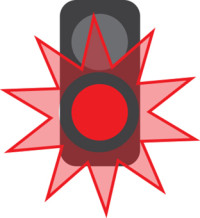There are some other signals that road users will use to communicate to you. You must know what these signals are and what to do when you see them.
Emergency vehicles, such as an ambulance, fire engine or police car, use sirens and/or flashing red, blue, or blue and red lights. If an emergency vehicle is coming towards or behind you with sirens and/or flashing lights, you must pull over, stop if necessary, and allow it to pass.

Flashing lights on an emergency vehicle
If a police car is following you with its siren on and/or flashing blue, or blue and red lights, you must pull over and stop as soon as possible.
You should remove your helmet and, if asked to, you must give the following to a police officer:

Flashing lights on a police car
If a vehicle is following you with flashing blue lights, you must pull over and stop as soon as possible. Flashing blue lights are used by customs officers, fisheries officers and marine reserve officers. These people have the right to stop vehicles.

Flashing lights on a customs/fisheries/marine reserve car
Doctors, nurses or midwives on urgent business may use a roof-mounted green flashing light. If you see these lights, you must pull over and allow the vehicle to pass.
When service vehicles, such as tow trucks and road maintenance vehicles, use flashing amber lights, they're warning you to be careful around them. When you see these lights, slow down and be prepared to stop, if necessary.

Flashing lights on a service vehicle
Oversize vehicles may use flashing orange lights and pilot vehicles may use flashing orange and purple lights. You may need to pull over or stop to let the vehicles pass.
Oversize vehicles and vehicle-mounted signs
Red flashing signals outside a fire station or airport mean you must stop and remain stopped until the lights stop flashing.

Flashing red signals
When a police officer is directing traffic, you must stop or go where the officer directs you. A police officer’s directions overrule:
If a police officer is controlling an intersection, be careful to get into the correct lane. If you don’t, you may have to go the wrong way.
Show the officer where you want to go by using your indicators.